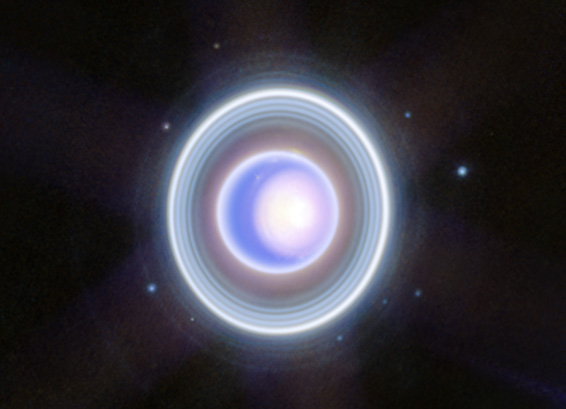NASA has revealed a stunning image of Uranus shining brightly against the darkness of space.
It gives space fans a glimpse of some rarely seen features of the distant planet – including one of Uranus’ rarely-seen rings.
The image of our neighboring ice giant was captured by Nasa’s James Webb Space Telescope.
It’s an updated version of a photo released earlier in 2023 with new “wavelength coverage” that reveals extra details.
Put a ring on it
One key highlight of the new image is the clear look at Uranus’ rings.
Normally in visible light photographs, Uranus appears like a featureless blue ball.
But by snapping a whole host of light wavelengths, the JWST is able to capture unseen details of Uranus.
“With its exquisite sensitivity, Webb captured Uranus’ dim inner and outer rings, including the elusive Zeta ring – the extremely faint and diffuse ring closest to the planet,” Nasa explained.
“It also imaged many of the planet’s 27 known moons, even seeing some small moons within the rings.”
Icy? I see!
The image of the icy planet also shows the north pole’s “cloud cap”.
Most read in News Tech
You can see the bright white “inner cap”, and the “dark lane” in the bottom of the polar cap.
If you look closely, you can see several bright storms just below the southern border of the polar cap.
The polar cap is increasingly bright and visible as it turns towards the sun.
It’s expected to receive maximum sunlight – the planet’s solstice – in 2028.
Each year on Uranus lasts 84 years.
And for a quarter of that Uranian year – roughly 21 years – one pole is constantly in daylight while the other is trapped in a “dark winter”.
Currently we can see the north polar cap, but by 2070 the southern pole will be facing us.
Uranus examined
Uranus is the seventh planet from our Sun, and is 1.6 billion miles from Earth at its closest point – or 1.98 billion miles at its farthest.
It’s an ice giant made mostly of water, ammonia, and methane.
And it’s unsurprisingly chilly, with a minimum temperature of -371F or -224C.
The planet is believed to have a rocky core that is surrounded by a thick atmosphere of hydrogen and helium.
Peak wind speeds in the atmosphere are said to reach up to 560mph.
The planet has a ring system and 13 inner moons – as well as nine “irregular” moons further out.
It’s possible to see Uranus with the naked eye due to its large size.
Read more on The Sun
But the distance makes it very difficult to spot without a clear sky and very little light pollution.
Science’s closest “visit” to the planet to date was the Voyager 2 probe fly-by in 1986.












